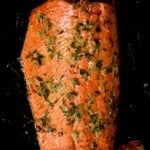The Best Oven Baked Salmon
Here is how to make the best oven baked salmon in just 25 minutes. It is tender and flaky, with a lemon-garlic flavor, and perfect with veggies, grains, salads, and more!
Servings: 2
Equipment
Ingredients
- 1/2 lb salmon fillets 2 medium-sized or 1 large; use skin-on, deboned wild-caught salmon like Sockeye or Coho or Chinook
- 1 Tbsp olive oil or another neutral cooking oil
- 1 lemon 3 Tbsp juice
- 2 cloves garlic minced
- 1/2 tsp salt or to taste
- 1/4 tsp black pepper
- thyme or rosemary; optional
Instructions
- Pat the salmon fillets dry with paper towels. Let them come to room temperature on the counter for 15 minutes.
- Preheat the oven to 375ºF/190ºC and line a rimmed baking sheet with parchment paper.
- Juice the lemon and mince the garlic, adding them to a small bowl with the olive oil. Brush this mixture into both sides of the salmon (or rub with your hands), seasoning it with salt and pepper afterward. Add the herbs (optional).
- Bake the salmon, skin-side down, at 375ºF/190ºC for 12-15 minutes, until it is light opaque pink and flaky. The exact time will depend on the thickness of your fillets.You can optionally broil the fillets for a minute or two at the end.
- Remove the oven-baked salmon from the oven and enjoy with your sides of choice!
Video
Notes
Optional Add-ins: smoked paprika, Italian seasoning or just oregano, honey or brown sugar, pesto.
To Store: Cool the leftover baked salmon before placing it in an airtight container in the refrigerator for up to 5 days. For longer storage, freeze the salmon in a Ziplock bag or freezer-safe container for up to 3 months. Thaw in the refrigerator overnight before reheating.
To Reheat: Warm the salmon in a skillet over medium-low heat with a splash of water, covered with a lid, for 5-7 minutes. Or microwave briefly until heated through.
Check the blog post for more tips and serving suggestions!
Nutrition
Calories: 390kcal | Carbohydrates: 2g | Protein: 45g | Fat: 21g | Saturated Fat: 3g | Polyunsaturated Fat: 7g | Monounsaturated Fat: 10g | Cholesterol: 125mg | Sodium: 682mg | Potassium: 1132mg | Fiber: 1g | Sugar: 1g | Vitamin A: 94IU | Vitamin C: 5mg | Calcium: 38mg | Iron: 2mg
